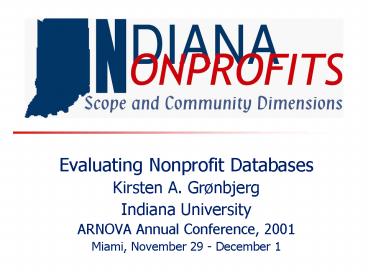Evaluating Nonprofit Databases - PowerPoint PPT Presentation
1 / 12
Title:
Evaluating Nonprofit Databases
Description:
Sector's Increasing size and economic force. Doubling in size ... Guidestar: web site of registered charities. Foundation Center: analysis of foundation grants ... – PowerPoint PPT presentation
Number of Views:27
Avg rating:3.0/5.0
Title: Evaluating Nonprofit Databases
1
- Evaluating Nonprofit Databases
- Kirsten A. Grønbjerg
- Indiana University
- ARNOVA Annual Conference, 2001
- Miami, November 29 - December 1
2
Why Evaluate Nonprofit Databases?
- Sectors Increasing size and economic force
- Doubling in size over 25-30 years
- Sectors growing visibility and policy relevance
- Long-term devolution from federal to
state/local levels - Long-term efforts to privatize government -
nonprofits - Increased political/policy role of religious
institutions - Charitable Choice Armies of Compassion
- Sectors visibility to social scientists
- Focus on building community capacity
- Concern about state of social capital, civic
engagement - Need data on sectors scope, characteristics,
trends
3
Methodological Developments
- National data
- IRS registered tax-exempt nonprofits
- NCCS, IS, CNP analysis of charitable filers
- Guidestar web site of registered charities
- Foundation Center analysis of foundation grants
- Taxonomies (NTEE) and data quality efforts
- Census of service industry, population
- Nonprofit Almanac IRS and Census data
national, state - State level data
- State charity officials
- Employment registration data
- Incorporation listings
- Department of Revenues, Tax
- Local level data
- Variety of approaches, use of available lists
4
Statement of the Problem
- Main database (IRS) is problematic
- Registration requirements (churches, small)
- Filing requirements (small, affiliates)
- Geographic biases (headquarter/backwater fiscal
agents) - Datedness (young, defunct)
- Incomplete enforcement, quality control
- Non-registration/filing rates are substantial
- Vary by field, religion, age, size, revenues,
region - No common identifiers to link with most other
databases - Implications
- Knowledge about sector may be incomplete and/or
biased
5
Indiana Nonprofit Sector Project
- Phase I in process
- Comprehensive database of Indiana nonprofits
- Examine gaps and overlaps in databases
- Survey nonprofits statewide and in 12 communities
- Profile sector and databases/approaches
- Phase II in planning stage
- Compare communities and their nonprofit profiles
- Phases III and IV - tentative
- Linkages/networks focus on role of
congregations - Curriculum additions adaptations (COP)
6
Building Comprehensive Nonprofit Database
- Institutional Database Approach
- Combine three databases IRS, SOS, CL
- Then draw sample
- Informant/Community Based Approach
- Supplement institutional database approach
- Then draw sample
- Hyper-network Approach
- Alternative sampling strategy
- Survey individuals on nonprofit affiliations,
involvement - Use listed nonprofits as sampling frame, avoid
database
7
Institutional Approach
- Combine three databases
- All IRS BMF 501(c) and NCCS Core filers w/
Indiana addresses - 32,600 (ca. 1999, 2000) exclude affiliates
located in other states, those with end-dates,
internal duplicates - SOS incorporated as nonprofits in Indiana
- 29,400 (2000, 2001) exclude out-of-state
addresses, internal duplicates - Congregational listings from yellow pages
- 9,000 (2000, 2001) exclude internal duplicates
- Total of 71,000 including cross-list duplicates
8
Assessing Institutional Approach
- Combined database 54,100 (from 71,000)
- Major gaps 71 percent on only one list
- IRS broadest coverage (60 percent)
- SOS substantial coverage (55 percent)
- CL narrowest coverage (17 percent)
- Small IRS/SOS overlap 23 percent
- Diverse institutional purposes
- Differ in combinations of active/defunct entities
- Differ in timing of listings
- Differ in nature of geographic biases
- Hidden duplicates (process, name/address
differences) - But broad consistency across communities
9
Informant/Community Based Approach
- Use of all available local listings
- 11 communities (size, region, characteristics)
- 8 local field associates
- Extensive field guide
- Added 5,000 for 11 communities
- Smallest additions 8-15 percent (fewest lists)
- Most communities 20-28 percent
- Extreme 64 percent (Scott County)
- If done for entire state perhaps 65,000 total
10
Personal Affiliation Approach
- Hyper-network approach
- Survey of 526 Indiana residents (May 2001)
- If work In Indiana? For nonprofit? Which (up to
2)? - If attend church In Indiana? Which?
- If attend membership events (21 types) In
Indiana? Which (up to 5 for each type)? - If do volunteer work (10 types) In Indiana?
Which (up to 5 for each type)? - Identified 1,290 organizations
- Deleted 184 (15) 113 public/for-profit, 71
duplicates - Remaining 1,106 57 on database, 13 incomplete
ID, 30 added to database
11
Database Assessment
- Assessment of work
- Complicated, difficult process chart
- Special database review and source fields
- Tentative coding of nonprofit field, type
- Preliminary findings
- Incomplete nonprofit databases and sector
definitions - Differences in sector composition by database
- Community variations in database size and
composition - Extrapolating to the U.S. nonprofit sector
- IRS registered nonprofits 50 ? 2.5 million
- IRS-registered charitable filers 10 ? 2.7
million - Nonprofit density 100 per 10,000 residents ?
2.8 million
12
Next Steps Nonprofit Survey
- Obtain more detailed information through survey
- Assess relevance of preliminary findings
- Address policy and substantive questions about
sector - Stratified sampling design
- Allow methodological comparisons of lists and
approaches - Allow Community comparisons expanded samples
- Survey design
- Format Mail questionnaire (20 minutes),
extensive follow-up - All Age, legal status, programs/services, impact
of community/policy changes, relations with other
organizations, human resources, finances,
management - Special Membership associations, congregations,
advocacy nonprofits































